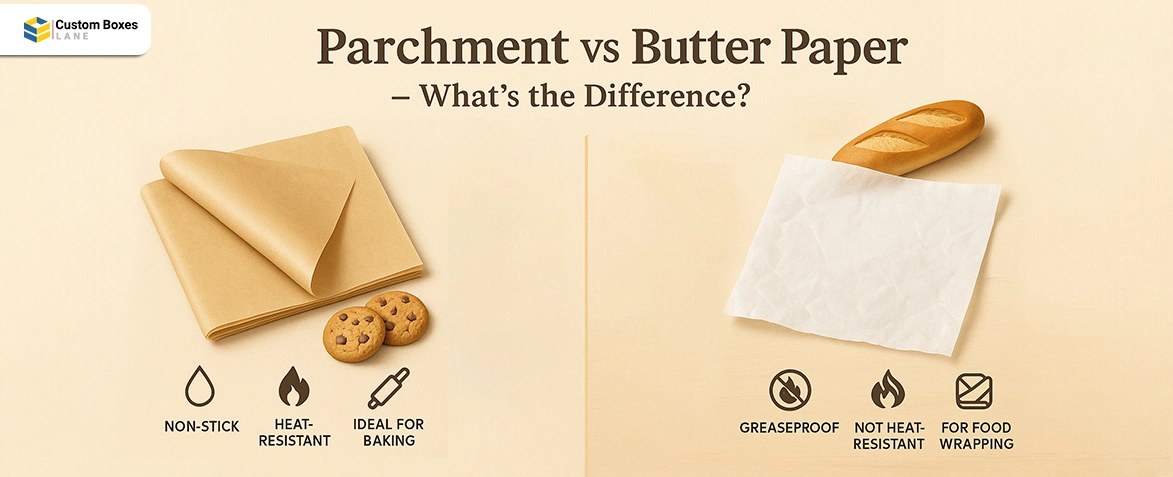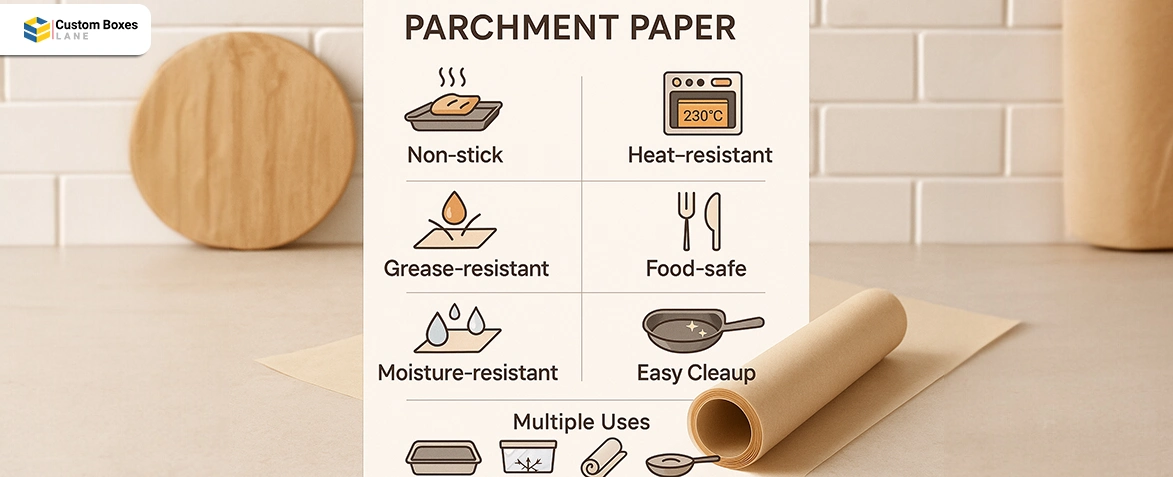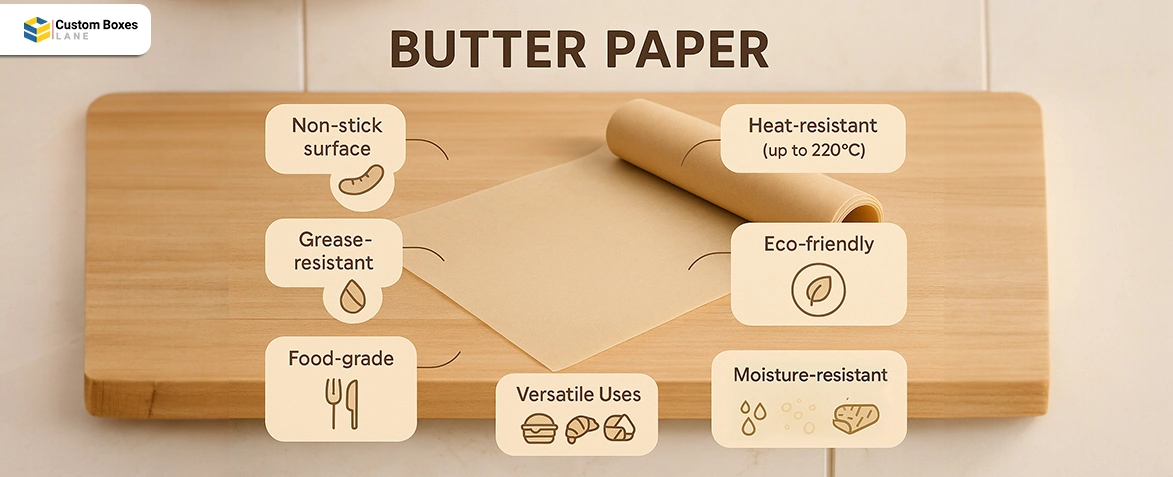A Comparative Review of Parchment Paper vs Butter Paper
Salman Shahid 2025-07-15 09:50:54

Parchment paper and butter paper are both popular owing to their greaseproof properties in baking and cooking. Both types of paper appear the same but differ. But they have distinctive properties, each serving different purposes, from food preparation, storing, baking, to cooking.
From restaurants, bakeries, to large-scale food brands and businesses should know the differences between parchment paper vs butter paper to serve customers best. Read this blog to have a detailed comparison of both greaseproof papers.
What is Parchment Paper?
Parchment paper is also popularly known as “Bakery Paper”, especially in the United States. Bakers and cooks both use this paper due to its excellent grease-resistant properties. Parchment paper has a non-stick surface due to a silicone coating. As a result, it prevents food from sticking while cooking or baking.
In other words, parchment paper or bakery paper is your go-to for baking and cooking at high temperatures.
Features of Parchment Paper

Parchment paper has become an essential kitchen tool due to its versatile features. Have a look at these features to assess their suitability for your needs:
- Non-stick: Create a surface that releases food without any hassle, without using greasing pans. Silicone coatings prevent food stickiness.
- Heat-resistant: Withstands high temperatures of up to 215 - 230°C, making it a safe option for the oven.
- Grease-resistant: Prevent oils and grease from soaking through parchment paper while keeping your baking sheets clean.
- Moisture-resistant: Stop food from becoming soggy, especially useful when baking or roasting due to moisture resistance.
- Easy Cleanup: Make your food cleanup a breeze by opting for parchment paper, as food residue doesn't stick to the paper.
- Food-safe: Ensure you are using culinary parchment paper, not craft parchment. Culinary parchment paper is generally safe for use in food preparation.
- Multiple Uses: Allow diverse tasks including baking, cooking, lining pans, wrapping food, and even in the freezer.
What is Butter Paper?
Butter paper is sometimes also known as “Sandwich paper.” This paper has a non-stick surface at only room temperature, unlike parchment paper. So, it is not suitable for use in baking. However, it is ideal for protecting the chopping board when you are about to prepare items like fish, raw meat, chili, or onion.
You can also wrap fatty and moist food with butter paper to preserve freshness and taste, such as when going for a picnic.
Features of Butter Paper

Although butter paper should not be used in the oven as it can’t withstand high temperatures like parchment paper. But it is ideal for food storage and wrapping. Plus, it stands out due to these features:
- Non-stick surface: Provides a surface where food is less likely to stick, making it ideal for food preparation and less suitable for baking.
- Grease-resistant: Keep food items fresh and clean by preventing oils and grease from seeping through butter paper.
- Heat-resistant: Withstanding temperatures up to 216 -220 °C in ovens, but not suitable for higher temperatures than this range.
- Moisture-resistant: Maintain the texture and integrity of your inside-wrapped fatty food items by blocking out moisture.
- Food-grade: Ensure the safety of inside-packed contents when you wrap sandwiches or other items inside butter paper.
- Eco-friendly: Support green credentials and minimize carbon footprint on the environment as butter paper is either biodegradable or compostable.
- Versatile Uses: Act as a one-stop solution for wrapping sandwiches, burgers, or pastries, for storage or to-go. You can also use butter paper for lining containers.
Is Butter Paper Same as Parchment Paper?
If you are still thinking, is parchment paper the same as butter paper? Then keep in mind that there are some similar properties in both types of paper. Let’s dive into that:
- Grease-Proof: Parchment and butter paper both are grease-resistant. Silicone coating makes parchment paper grease-resistant. However, wax coating makes butter paper grease-proof.
- Non-Stick: The silicone and wax coatings on parchment and butter paper make their surface non-stick. However, parchment paper is more non-stick than butter paper.
- FDA- and FSC-approved: Made from wood pulp, both types of paper are safe to use for direct food contact. And they are approved by international food authorities like the FDA and FSC.
- Wrapping Options: Both paper types are used to wrap fatty foods, trays, and present food without any fuss, owing to their high-fat content.
Explore Differences Between Parchment Paper and Butter Paper
To answer your question: Are butter paper and parchment paper the same? Well, they have partial similarities, but there are also some major differences. Explore these differences:
than parchment paper.
What Should You Choose: Parchment Paper vs Butter Paper?
Put simply, if you want to bake products in a microwave or an air fryer, don’t use butter paper. The reason wax coating on butter paper can melt at high-temperature and may catch fire. So always prefer parchment paper for oven usage.
But if you are more concerned about the price factor, then opt for butter paper due to its cost-effectiveness, mild baking and effective wrapping abilities. To sum up, use parchment paper to meet your ideal baking needs and butter paper for wrapping or doubt rolling needs. Switch between parchment paper and butter paper depending on your needs.
Where to Customize Parchment and Butter Paper?
To elevate your baking and cooking business, invest in customized parchment paper and butter paper. Print these paper types with your brand logo and tagline to build brand recognition in the competitive food market. Contact Custom Boxes Lane and get custom printed butter and parchment paper with food-safe inks.

